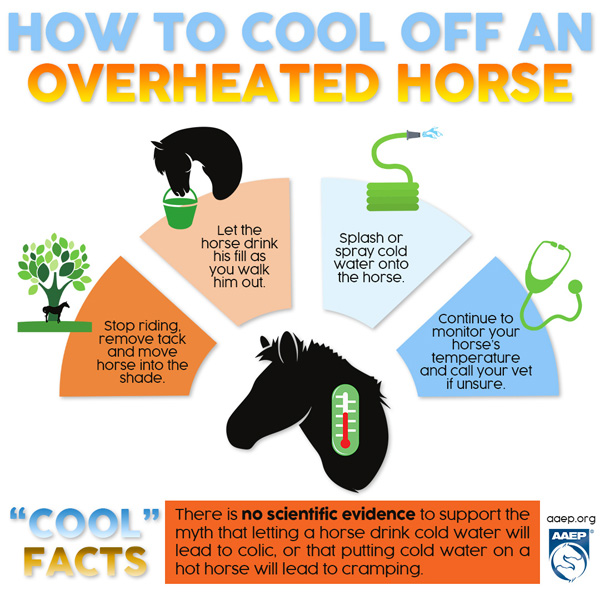Heat Stroke Signs from American Association of Equine Practitioners
Heat Stroke
By Steven M. Haugen, DVM, AAEP
The body maintains its normal temperature in hot weather by moving heat through the muscles and out through the skin. Blood also removes heat as it circulates through the body and releases it through lung tissue, skin and expanding blood vessels. This is why our own vessels and the horse’s blood vessels may appear larger and more distended during hot weather. This serves to cool the skin as it evaporates. Horses that cannot sweat will usually overheat very rapidly, even in cooler weather with a small amount of exercise. Other factors may increase heat in the body other than just outside temperature.
A major source of body heat is exercise. The more a horse exercises, the more heat it produces. Another source is feed. All feed releases heat as it is digested. Approximately 50% of the energy in oats is released as heat. When the sum of outside temperature plus the relative humidity is below 130 (e.g., 70 F with 50% humidity), most horses can keep their body cool. The exception will be very muscular or fat horses.
When the sun temperature and humidity exceeds 150 (e.g., 85 F and 90% humidity), it is hard for a horse to keep cool. If the humidity contributes over half of the 150, it compromises the horse’s ability to sweat – a major cooling mechanism. When the combination of temperature and humidity exceeds 180 (e.g., 95 F and 90% humidity), the horse’s cooling system is almost ineffectual.
At this stage, exercise can only be maintained for a short time without the animal’s body temperature— especially in the muscles— rising to dangerous levels. Very little cooling takes place even if the horse is sweating profusely. When the horse’s body temperature reached 105 F, the blood supply to the muscles begin to shut down. After this occurs, the blood supply to the intestines and kidneys also shut down.
The blood supply to the brain and heart are spared until last, but severe and permanent damage may have already taken place.
Signs of heatstroke may include the following:
1). Temperature as high as 105 to 107 F
2). Rapid breathing, rapid pulse
3). Stumbling, weakness, depression
4). Refusal to eat or work
5). Dry skin and dehydration
6). In severe cases, a horse may collapse or go into convulsions or a coma
Treatment
When possible, place the animal in shade. A breeze can be added with a fan. In order to cool the body, ice the major blood vessels. The vessels that should be iced are the jugular veins, the major veins that run down both sides of the neck; the veins on the inside of the front of the legs and the large veins on the inside of the back of the legs. Ice packs or cold water from a hose will cool down the blood as it circulates through the body. It acts as the “antifreeze” and cooling system as it circulates. Avoid icing the large major muscles of the loin and hind end. These muscles are already lacking blood circulation and may make the condition worse. You may ice the forehead since the brain contains the temperature control center for the body, and this will help to cool the horse. Small amounts of water should be provided to re-hydrate the horse. Electrolytes may also be given orally. In severe cases, intravenous fluid therapy is necessary to treat dehydration, electrolyte loss and shock.
Remember that signs of heat stroke may range from mild to severe and life-threatening. Foals usually cannot take as much heat as adult horses. A mare may be fine, but her foal may be getting sick from being out on a hot day. Horses with heavy muscling or excess fat or in poor condition will have more problems. Keep in mind that strenuous exercise on a hot, humid day can lead to problems in a short period of time for even the best-conditioned horse.
Reviewed by original author in 2016.











